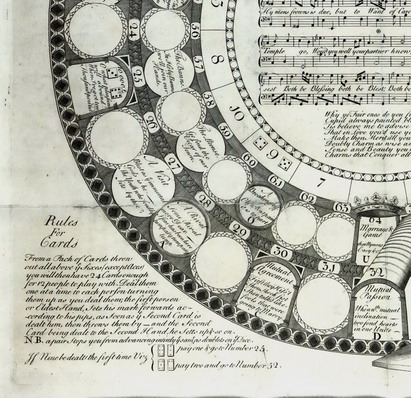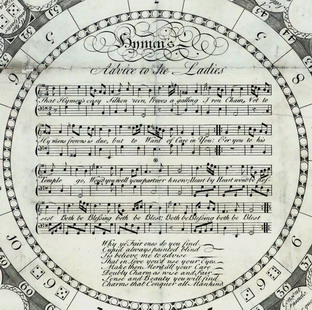Giochi dell'Oca e di percorso
(by Luigi Ciompi & Adrian Seville)
(by Luigi Ciompi & Adrian Seville)

|
Giochi dell'Oca e di percorso
(by Luigi Ciompi & Adrian Seville) |

|
 |

Torna alla ricerca giochi (back to game search) |
 |
| Courtship and Matrimony | ||
 |
Versione stampabile
 |
Invia una segnalazione

|
   |
primo autore: | Non indicato |
| secondo autore: | Roberts H. (?) | |
| anno: | 1747ca | |
| luogo: |
Inghilterra-Londra |
|
| periodo: | XVIII secolo (2°/4) | |
| percorso: | Percorso di 64 caselle numerate | |
| materiale: | carta (paper) (papier) | |
| dimensioni: | 600X480 | |
| stampa: | Acquaforte (taille-douce) (ecthing) | |
| luogo acquisto: | ||
| data acquisto: | ||
| dimensioni confezione: | ||
| numero caselle: | 64 | |
| categoria: | Vita umana, attualità, lavoro e tempo libero | |
| tipo di gioco: | Gioco di percorso | |
| editore: | Non indicato | |
| stampatore: | Non indicato | |
| proprietario: | Collezione A. Seville | |
| autore delle foto: | A. Seville | |
| numero di catalogo: | 978 | |
| descrizione: |
Gioco di 64 caselle numerate, spirale (circolare), antiorario, centripeto. REGOLE: riportate sul tavoliere. CASELLE: alcune con didascalia. REFERENZA 1 COURTSHIP and MATRIMONY. [N.p., but probably London: H. Roberts, 1747]. Copper engraving, 60 × 48 cm. The subtitle reads: “A new invented Entertaining Game for a Large Company to be Play’d not only with Dice, as the Goose & the Snake, But also with CARDS or an INDEX.” The meaning of this will be explained later. The most obvious feature of this game is the music printed in the center, which is a duet giving “Advice to the Ladies,” beginning: That Hymen’s easy Silken rein / Proves a galling Iron Chain, Not to Hymen’s Frowns is due / But to want of Care in you. Courtship and Matrimony is in fact closely based on Goose, though its track ends at space 64, marked “Marriage and Game.” The track is formed by two concentric circles, linked at space 32, which is gloriously labelled “Mutual Passion - When w[i]th Mutual inclination two fond Hearts in one Unite.” The goose doubling-type spaces are those that are inscribed but have no reference to any particular rule. The spaces are inscribed with mottoes and quotations from popular ballads of the day, e.g., space 5: A Wounded Heart. By Cupid’s Self I have been told, He never wounds a Heart. With further examples of this kind, two series of favorable spaces are formed. As expected, there are special rules for an initial throw of nine, both symbolizing advancement in life, as well as on the board. For example, the throw of 6, 3 leads to: space 25 (£10,000 - O what pleasures will abound / When I’ve got ten thousand pound). There are also baulks (hazard spaces); for example, space 28 (A Rival - Some Rival more Dear / I fear has been here / tumpaty, tumpaty, tump) - go back to space 7 and lose a turn. The prison space is particularly interesting: space 55 (The Fleet - But Kind S[i]r As you’re a Stranger / Down your Garnish you must lay). The Fleet Prison in London was a debtor’s prison and the rule is basically the standard prison rule: wait until released by another. However: “If one of ye other Sex comes in, it is a Fleet Marriage & you win the Game and divide the Pool.” A Fleet marriage was one that took place in that prison, which claimed to be outside the jurisdiction of the Church. Disgraced or pretending clergymen often conducted them, for a fee. Such marriages were in fact legal in Britain until the Marriage Act of 1753. The final baulk corresponds to the death space at 61 (A Breaking Off - Oh What Pain it is to Part); pay 1 and begin the game again. The reference in the subtitle of both versions to playing the game “not only with dice but also with cards or an index” needs explanation. The use of two dice is straightforward, except that there is a rule that doublets are not played: the player remains without moving. The “cards” are just a pack from which all above the sixes have been removed. Drawing two cards simulates the throw of two normal dice; drawing a pair simulates doublets and the player does not move. The “index” is a spinning arrow placed centrally on the game, laid horizontally on a table. When spun, its resting point indicates a number on the index ring, which is cleverly divided to simulate the chances on double dice, an impressive achievement, considering the generally low level of understanding of chance in the mid-eighteenth century. The inventor of the game is not known, though a notice of a now-lost version published by Bladon as a “new game” in 1754 attributes it to “a country clergyman.” (Adrian Seville) Exhibitions: - "The Royal Game of the Goose four hundred years of printed Board Games". Exhibition at the Grolier Club, February 23 - May 14, 2016 (Prof. Adrian Seville). |
|
| bibliografia: |
1) SEVILLE, Adrian: "The sociable Game of the Goose" in "Board Games Studies Colloquia XI", 23-26 Aprile 2008, Lisbona - Portogallo 2008. 2) SEVILLE, Adrian: "The Royal Game of the Goose four hundred years of printed Board Games". Catalogue of an Exhibition at the Grolier Club, February 23 - May 14, 2016. |
|
Vai alla ricerca giochi Vai all'elenco autori